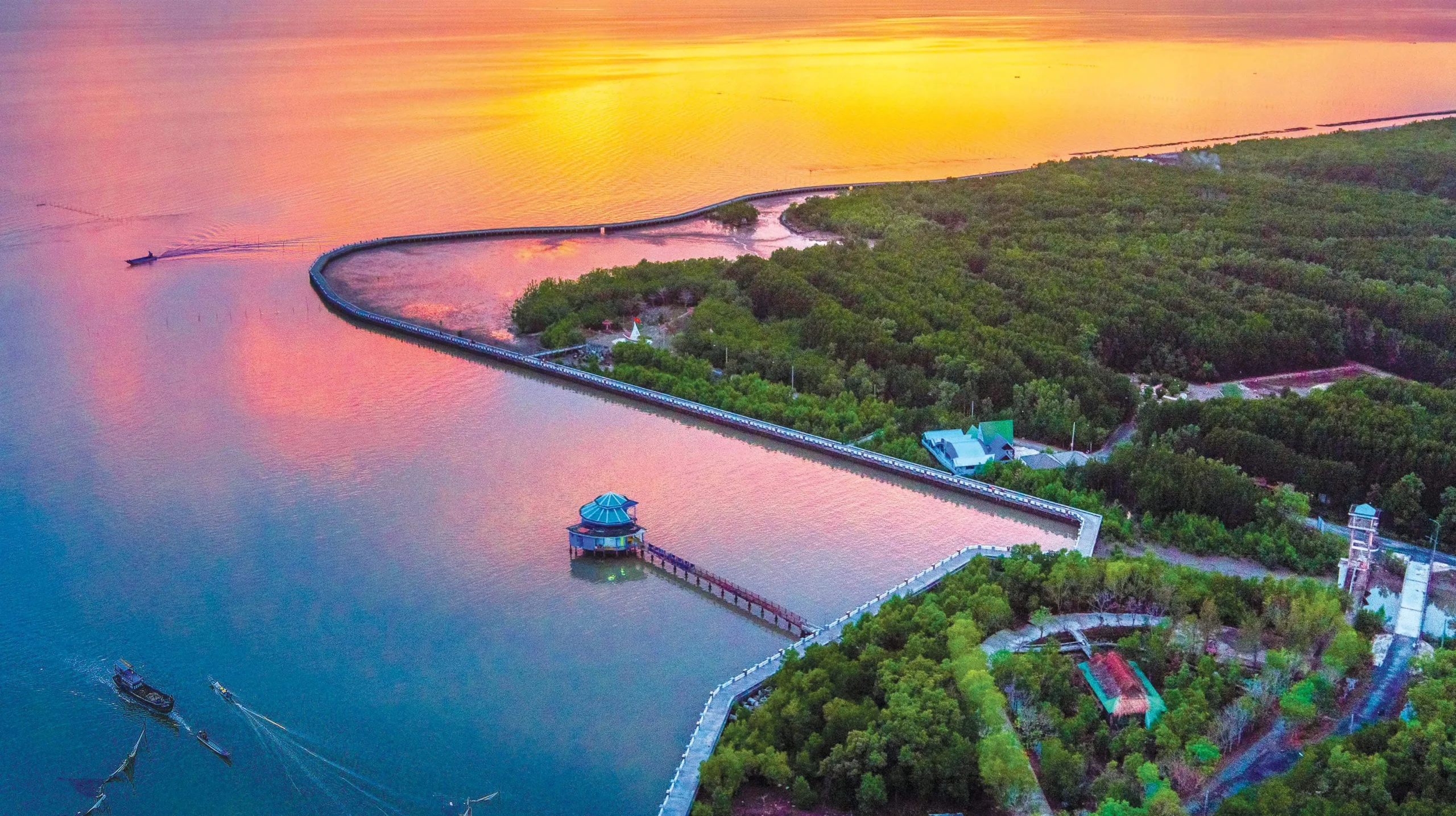Ca Mau, the southernmost land of Vietnam, has always been an attractive destination for those who love to explore the pristine and unique beauty of the Mekong Delta. With this detailed Ca Mau travel guide, Du Lịch Khắp Thế Gian will share self-sufficient travel experiences to help you have a complete and memorable journey to explore Ca Mau.
1. Ca Mau Tourism Overview: The Land of Golden Forests and Silver Seas
Ca Mau is not only the end point of the Vietnam map but also the intersection of two special ecosystems: mangrove forests and brackish forests. This combination creates a diverse and rich natural picture with vast rice fields, lush orchards, natural bird sanctuaries, and winding rivers.
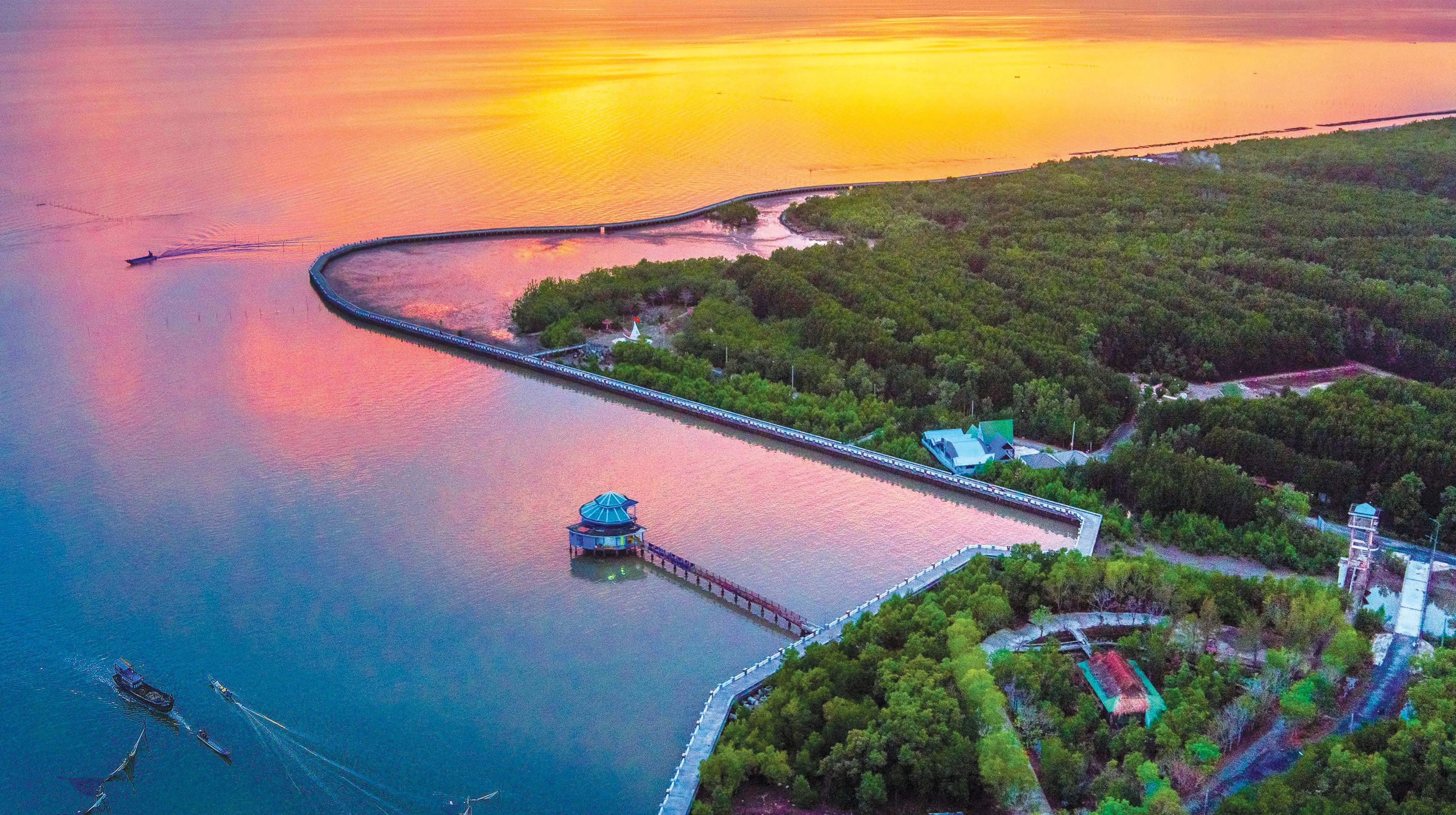
Moreover, Ca Mau tourism attracts visitors with its historical relics and traditional festivals imbued with the cultural identity of the Kinh, Hoa, and Khmer communities. And especially, when coming to Ca Mau, you will enjoy specialties with the typical flavor of “golden forests and silver seas”.
2. Ideal Time to Visit Ca Mau: Which Season is the Most Beautiful?
Ca Mau has the characteristics of a tropical monsoon climate near the equator, with two distinct seasons:
- Rainy season (May to November): The weather is humid with a lot of rain, suitable for those who want to experience the peaceful and tranquil space of the Mekong Delta.
- Dry season (December to April of the following year): The weather is dry, with light sunshine and cool air, ideal for sightseeing and outdoor activities.
According to Ca Mau travel experience, the best time to come here is in the dry season. At this time, you can comfortably explore tourist attractions without worrying about the weather.
3. Getting to Ca Mau: Which Transportation to Choose?
There are many means of transportation for you to choose from when traveling to Ca Mau:
3.1. Airplane: Fast and Convenient
Currently, only Vietnam Airlines operates flights from Ho Chi Minh City to Ca Mau, with a frequency of 1 flight/day. If you are in other provinces, you can fly to Ho Chi Minh City first and then take a connecting flight to Ca Mau.
- Ticket price: Approximately VND 1,000,000/one way.
- Flight time: Approximately 1 hour.
3.2. Sleeper Bus: Popular and Economical
Sleeper buses are a popular means of transport for many tourists due to their convenience and affordability. You can easily book tickets online or at bus stations.
- Reputable bus operators: Phuong Trang, Thanh Buoi, Van Lang, Viet Hoang…
- Ticket price: VND 150,000 – 210,000/ticket.
- Travel time: Approximately 8-9 hours.

3.3. Motorbike: For Adventurous Souls
If you are someone who likes to experience and explore, a motorbike is a great option. However, the distance from Ho Chi Minh City to Ca Mau is quite long (over 300km), you need to prepare carefully in terms of health and vehicles.
- Suggested route: Ho Chi Minh City – Binh Chanh – My Yen – Ben Luc Bridge – Tan An Bridge – My Tho – My Thuan Bridge – Can Tho Bridge – Nga Bay Town – Quan Lo – Phung Hiep – Ca Mau.
Note:
- The Quan Lo – Phung Hiep – Nam Can section does not have street lights, so travel during the day to ensure safety.
- Check your motorbike carefully, bring all papers and comply with traffic laws.
4. Getting Around Ca Mau: Rent a Motorbike or Take a Taxi?
In Ca Mau, you can choose the following means of transport:
4.1. Taxi: Convenient for Families and Large Groups
Taxis are a suitable choice if you are traveling with family with elderly people and children.
- Popular taxi companies: Ca Mau Taxi, Mai Linh Taxi, Huong Sen Taxi, Dat Mui Taxi…
4.2. Motorbike: Freedom to Explore
Motorbikes are a flexible and cost-effective means of transport. You can easily rent a motorbike at hotels or motorbike rental shops.
- Rental price: VND 100,000 – 150,000/day.

4.3. Rent a Car with a Driver: Comfortable and Proactive
If you want to have a comfortable and proactive trip, renting a car with a driver is a good option. You will be advised on the itinerary and do not have to worry about finding directions.
5. What to Explore in Ca Mau? Must-Visit Destinations
Ca Mau has many attractive destinations, from pristine mangrove forests to ancient pagodas and bustling floating markets. Here are some places you should not miss when coming to Ca Mau:
5.1. Cape Ca Mau: The Southernmost Point of the Fatherland
Cape Ca Mau is a symbol of Ca Mau tourism, where you can set foot on the southernmost point of the S-shaped strip of land. Here, you can admire the national coordinate landmark, the ship symbol, and the typical mangrove ecosystem.
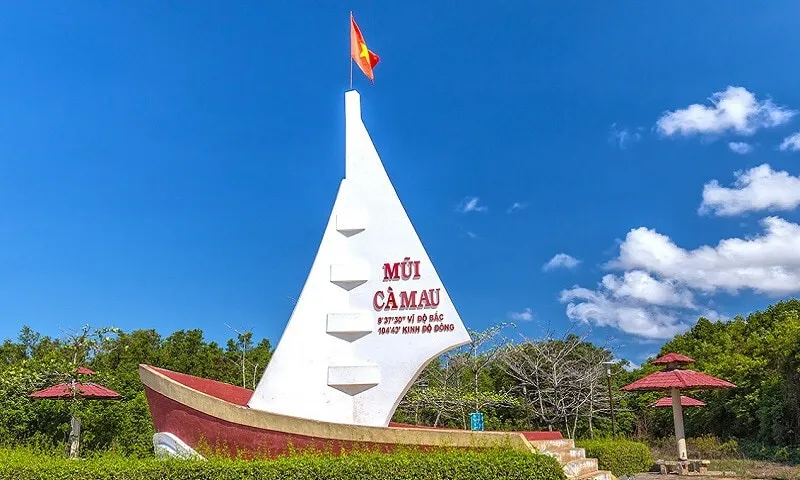
5.2. Mui Ca Mau National Park: World Biosphere Reserve
Mui Ca Mau National Park is the largest primary mangrove forest in Vietnam, with a rich and diverse flora and fauna system. This is where you can explore the pristine beauty of nature and learn about rare animal species.
5.3. Ca Mau Bird Sanctuary: Paradise of Birds
Ca Mau Bird Sanctuary is one of the largest bird sanctuaries in the Mekong Delta, where you can admire thousands of birds flying in the sky.
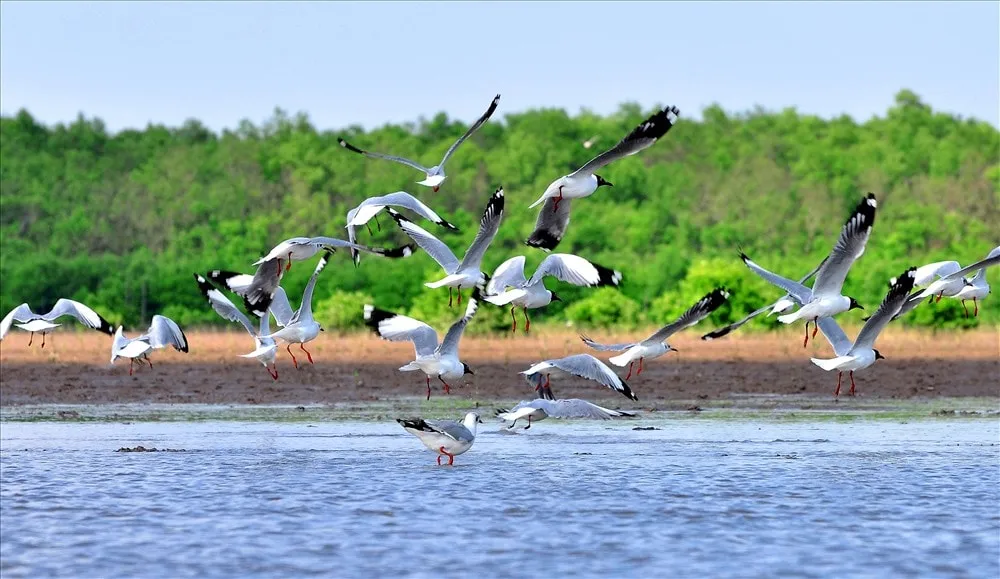
5.4. Ca Mau Floating Market: Unique Cultural Feature of the Mekong Delta
Ca Mau Floating Market is one of the largest floating markets in the Mekong Delta, where you can experience river life and enjoy local specialties.
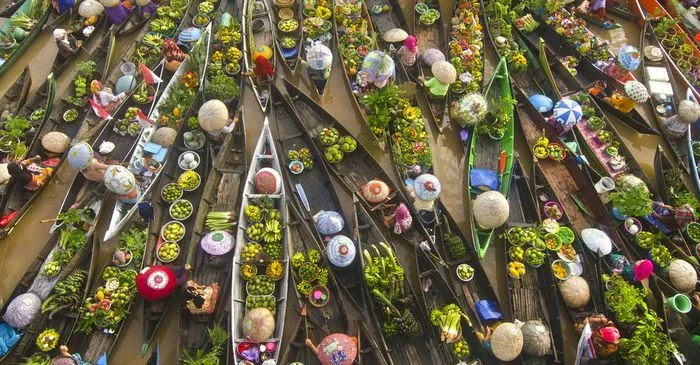
5.5. U Minh Ha Melaleuca Forest: The Largest Flooded Forest in Vietnam
U Minh Ha Melaleuca Forest is the largest flooded forest in Vietnam, with a diverse and rich ecosystem. Here, you can take a boat through small canals, admire the green melaleuca forests, and learn about the typical flora and fauna of the region.
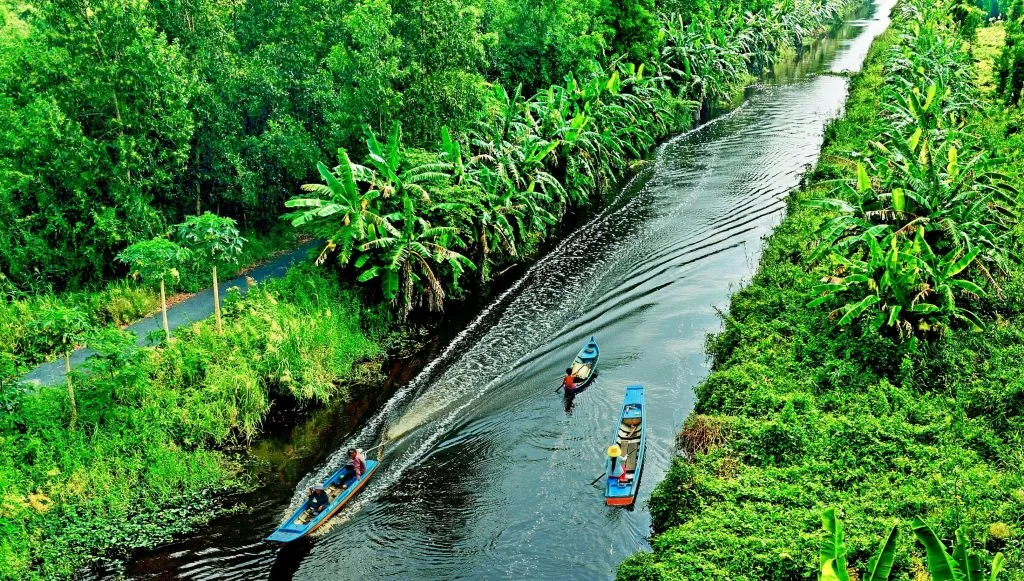
5.6. Ancient Pagodas: Spiritual Destinations
Ca Mau has many ancient pagodas, imbued with Khmer and Chinese architecture. Some famous pagodas you should visit are Phuoc To Pagoda, Ba Thien Hau Pagoda, and Monivongsa Bopharam Pagoda.
5.7. Thi Tuong Lagoon: “Lake in the Middle of the Plain”
Thi Tuong Lagoon is a large natural lagoon, likened to a “lake in the middle of the plain”. Coming here, you can enjoy fresh seafood and experience the simple life of local people.
5.8. Tu Su Bird Garden: Watching Storks Flying
Tu Su Bird Garden is home to thousands of storks, especially during the breeding season (June to January of the lunar calendar). Coming here, you will admire the beautiful scenery when white storks fly in the sky.
5.9. Ca Mau Night Market: Food and Shopping Paradise
Ca Mau Night Market is where you can enjoy specialties of the Cape Land and buy souvenirs.
6. Accommodation in Ca Mau: Which Hotels and Homestays are Good?
In Ca Mau, there are many accommodation options to suit all needs and budgets:
- Hotels: Long Ty Hotel, Ngoc Bich Hotel, Thanh Truc Hotel, Muong Thanh Hotel…
- Homestays: Garden homestays with a nature-friendly style.
7. Ca Mau Specialties: What to Buy as Gifts?
Ca Mau has many delicious and unique specialties that you can buy as gifts for relatives and friends:
- U Minh forest honey
- U Minh dried snakehead fish
- Rach Goc dried shrimp
- Thoi Binh fermented fish sauce
- Fermented goby fish
- Cai Tau durian
- Tra Giac wine
- Fresh and dried seafood
8. Suggested 3 Days 2 Nights Ca Mau Itinerary
Here is a suggested 3 days 2 nights Ca Mau itinerary:
- Day 1: Ho Chi Minh City – Bac Lieu – Ca Mau (visit the house of Bac Lieu mandarin, enjoy Ca Mau specialties)
- Day 2: Ca Mau (visit Mui Ca Mau National Park, check-in the landmark, explore Thi Tuong Lagoon, stroll around the night market)
- Day 3: Ca Mau (visit Monivongsa Bopharam Pagoda, shop for specialties, end the journey)
9. Notes When Traveling to Ca Mau
- Choose the right time to travel according to the weather.
- Plan your trip in detail.
- Prepare enough personal luggage.
- Bring enough cash.
- Protect the environment and maintain general hygiene.
- Respect local culture and customs.
- Find out information about attractions carefully.
- Book rooms and bus tickets in advance to avoid running out of space.
With the experiences and detailed information in this Ca Mau travel guide article, Du Lịch Khắp Thế Gian hopes you will have a fun and memorable trip to Ca Mau Cape Land!
